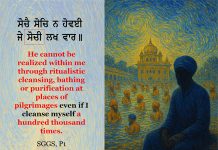
By Jasbir Singh Sarna | Culture |
The word Gurmukh is ancient and is found in the old Siddha literature of Nath Jogis of the tenth and eleventh centuries. Scholars have differing views on the origin of the name Gurmukhi. In fact, Gurmukh Naam has also appeared in the meaning of “Bhale Purash”. Pandit Gauri Shankar writes in his commentary on ‘Gurmukhi’: “It contained Sindhi-like amount of vowels . It is said that the scriptures of the Sikhs were also earlier written in such a script which made it difficult for them to read in pure form. Guru Angad (1504-1552 AD), therefore, devised a new script for the accuracy of his scriptures so that it could be read and written in a pure form like Nagari. For this reason it is called ‘Gurmukhi’ i.e. the script derived from the mouth of the Guru.”( Bhartiya Prachin LipiMala, 2001, P.155)
According to Prof Piara Singh Padam, “When the Punjabi script was suppressed under the Muslim influence and the Punjabi script was revived, the country’s self-respecting Gurus revived the Punjabi script. Since the people who believed in the Guru were called ‘Gurmukhs’, the name ‘Gurmukhi’ was given due to their use. These Gurmukh Sikhs memorized the Guru’s word and preached from place to place. There was also a need to write Bani for this type, so he used the script prevalent in Punjab at that time for this purpose and this use has made the new name ‘Gurmukhi’ more popular.”(Gurmukhi Lipi da Itihas, 1953, P:54-55)
Dr. Kerry calls Gurmukhi “Gurmukhi Nagari”. Dr. Leitner also considers Guru Angad to be the originator of Gurmukhi characters.
“Guru Angad, like Professor Huxley, did not consider it beneath his dignity to write primers for children and he accordingly composed a number of mottos and moral maxims which accompany the letters of the alphabet.”
“Gurumukhi, however is not a name for a mere character, as is supposed both by the native, including now even, the sikhs themselves, and by Europeans. Etymologically, it is the name of the language, which flowed from the mouth of the Guru Nanak and although his sayings were subsequently committed to writing by Arjan, The characters though not the name, existed before Nanak.” (Lietner, 1883,P:1,29)
Many scholars have commented on this point . Sardar G.B. Singh argues that “it is possible that Guru Angad Dev Ji wrote some ‘Bal Bodh’, because there were no printed books at that time. Then the first question arises whether these were Gurmukhi characters or Lande which are needed more by the Shopkeepers . Even if they are Gurmukhi characters, then there is not much evidence of making or inventing Gurmukhi characters. But later it was a natural thing for the devotees to carry on the tradition that Guru Angad had made Gurmukhi. With this another thing came together and the name of this alphabet became ‘Gurmukhi’. (Gurmukhi Lipi da Janam te Vikas,2020,P.110)
At the beginning of the spiritual movements, innumerable Sadhus, Saints, Jogis, Naths etc, spoke a central language throughout India which they called Sant Bhakha or Sadhukari. It is mentioned that before the Sikh Gurus, samples of Gurmukhi-like writing were visible in Punjab. Guru Sahib revived the same script and made it famous and popular. Guru Angad preached and propagated the writing of Bani and biographies of Guru Nanak, due to which it became popular among the common people that Guru Sahib had invented the script. He writes, “Guru Angad Dev Ji Maharaj considered that the language of each country and its characters are different. Guru Nanak Dev Ji Maharaj was born in Punjab and composed words in the language of this country. But considering that he created an alphabet of thirty five letters, which is called Gurmukhi, and nowadays the Punjabi alphabet can also, very beautifully composed ……”

It has been a tradition since ancient times for children to write letters. Pandhe, Bhai, Maulvi, Pandit used to add a sentence to the letters which was repeated while writing the letters. Sheikh Saadi, Amir Khusra etc. also wrote about Karima, Wahid etc. to teach children. Guru Angad also developed a ‘Bal bodh’ for children, women to learn and write. Dr Leitner gives Balbodh with a similar thirty five letter reference. Dr. Mohan Singh Deewana sheds light on the dichotomous aspect of ‘Bawan Akhari’ and clarifies that the alphabet has been used to authenticate spellings, to spell them correctly and to combine spiritual meanings with the letters, as in Sanskrit ‘Ekakshari’ Hindi. Kanpate Nath’s ‘Chetisi’ in Hindi ‘Bawan Akhri’ in Punjabi ‘Patti’ or ‘Panti Akhri’ etc.( A History of Punjabi Literature ,1956,115)
Guru Nanak and Guru Angad must have ‘corrected’ the Gurmukhi characters but the fact is that the ‘Gurmukhi’ characters were present before Guru Sahib.
Even though the name was not prevalent in Gurmukhi at that time. If they did not come into existence then the question arises, how did Guru Nanak write the Bani ‘Patti’: Patti is a wooden board on which children learn to write the alphabet. The tradition of the ‘Patti’ form of poetry is very old. Siddha Acharya Sarhapa has composed poems with many letters of the alphabet at the beginning of each Duae.(Punjabi Sahit Kosh,3rd,P 7-8).To say that the ‘Gurmukhi characters’ created by Guru Angad after the existence of these thirty five letters is tantamount to ignoring the written Patti script of Guru Nanak .
Although there are three more characters in this strip, that too only to express the parable of Almighty , but still the number thirty five is complete. In Sri Guru Granth Sahib there is a couplet of Asa Mahala ੧ and after that comes the couplet of Guru Amar Das . If Guru Angad had written the couplet, then it must have existed before Guru Amar Das’s couplet? It can also be said with confidence that Guru Nanak must have written his Bani with his august hands . Guru Angad would have recited all his Bani because Guru Nanak would have written the difficult words ofGatha,Sanskrit, Persian etc. with his own hand. Guru ji may have also written the verse of Bhai Mardana.
Aburehan Al-Bruni (c. 1030 AD) in his famous book, Alhind, quotes the script as “semi-nagari”. According to him, the combination of Siddha-Matrika developed from Sharda and the script developed from Nagar script has resulted in a semi-nagari script, the propagation and use of which is prevalent in Bhatti Desh and Sindhu. Only semi-nagari were used in business. Kala Singh Bedi is of the opinion that the pronunciation of these letters was the same now as Ura, Era, Kaka, Gagga, Chacha, Pappa etc. Gurbani also proves that the order of these letters was not the same as now and the shape of some of the letters was also different from the present ones.(Khoj Patrika,2005,p:26). The order of the semi-nagari characters of the time of Guru Nanak and the order of the characters of the present Gurmukhi script are given in a table separately .
It is clear from the table that Guru Angad made it easier by changing the shapes of some difficult characters. Guru Nanak brought a new twist in language and script. Guru Sahib chose the scientific Gurmukhi script (semi-nagari). Guru Angad had ordered Pade Mokha to transcribe Janamsakhi Bala. Pade Mokha was familiar with Gurmukhi characters and Devanagari characters. This is the reason that Bale Wali Janam Sakhi was transcribed by Pade Mokha in Gurmukhi characters.
Sardar GB Singh has read the inscriptions on the stones in many wells of the Punjab, which are from before Guru Nanak. The characters in the inscriptions are similar to Gurmukhi. Museums of Nagpur. He also saw the shape of the Punjabi letter (b) on a stone in the 8th century. Sardar GB Singh is also of the opinion that every letter of Gurmukhi came into existence before the time of Guru Nanak’s enlightenment. Some research scholars have found in the books of Haridwar, Mathura, Bindraban and Kashi’s dias the signatures of the Hindu pilgrims who preceded Guru Nanak, which are similar to the Gurmukhi characters. The characters of that time may have been considered to be of semi-nagari script.
In a nutshell we can say that Gurmukhi characters were prevalent in Punjab long before Guru Nanak. The number of sounds uttered by the people in Punjab during the Vedic period is estimated by scholars to be 52. With the passage of time, their number was declining and thirty five (35) Gurmukhi voices were left before Guru Nanak Sahib. ‘Brahmi to express these sounds. Semi-natives developed from Punjabi which were letters that crossed the Sharda script. So Gurmukhi script is scientifically correct for the expression of Punjabi sounds. Letters were written at the feet of Devanagari characters but Gurmukhi is becoming free from this tradition. We can proudly say that Gurmukhi script is very useful for the Punjabi language. The literary treasure of the Punjab exists in Persian script, inscribed by peasants, Sufis, and Islamic preachers. A lot of Punjabi literature is also available in Devanagari. If Punjabis are able to present any script in the whole world in the color of Punjabiat then it can only be called Gurmukhi script. Guru Nanak was fluent in many languages and other Gurus and Gurmukhs maintained this tradition. Following in the footsteps of the original doctrine of the Gurus, the Gurmukhs, Bhagats, Sikhs adopted the script wholeheartedly and the script emanating from the Guru’s mouth became known as Gurmukhi. The meanings of the word ‘Gurmukhi’ are different from ‘Gurmukh’ and are reserved only for the Gurmukhi alphabet or thirty five letters. Thirty-five Gurmukhi characters, Sharda, Lande, Takri, etc., are considered to be a modified form of the script. In addition to these thirty-five letters, some Persian sounds have started to be punctuated to write them correctly or in tatsam form through Gurmukhi script. Looking at history, the first sign of Gurmukhi is inscribed in the books of Baba Mohan. The name existed in the time of Guru Amar Das. According to Prof Pritam Singh, there are references to three old opinions about the origin of Gurmukhi. The oldest of these schools of thought considers Guru Angad to be the master of the script. The earliest evidence of this doctrine is found in a pothi prevalent in Patiala under the name of Baba Mohan ji. This book contains two very interesting passages.
The historian Giani Gian Singh (1822-1927 AD) has also given the date of formation of these letters.” In 1598 , so he used to write Baba ji’s words (which were written by the people in Nagari, Persian, Turkish and Takri letters) and the story narrated by Bhai Bala (whose name is now Janamsakhi) from Bhai Pede Mokha Khatri (Who knows all Alphabets), writing date 1602 AD. According to Giani Gian Singh in Sammat 1598 (1541 AD), Guru Angad made Gurmukhi characters. Kesar Singh Chibber has linked the Gurmukhi characters with Sri Chand (Guru Nanak’s eldest son), which does not meet the test criteria.
Finally we come to the conclusion that the Gurmukhi script is the scientific script of Punjabi. Although its origin is the Brahmi script which came into existence from ancient pictographs. Vedic language as it evolved and passed through stages became modern Punjabi. Similarly, the Brahmi script, Sharda and the Gurmukhi script, which transcends the stages of Ardh-Nagri or Bhatt-Akhari, is easily seen on the world stage. The Gurus made it very popular by spreading like beads of rosary dissemination. That is why this Panti Akhri became the ‘Isme-Azam’ of the Sikhs.

Dr Jasbir Singh Sarna, a native Kashmiri, is a retired Indian agriculture officer. He has authored more than four dozen books, including Sikhs in Kashmir and The Sikh Shrines in Jammu and Kashmir. He can contacted at Jbsingh.801@gmail.com
RELATED STORY:
Inspiring Life of Guru Gobind Singh Ji (Asia Samachar, 17 Jan 2023)
ASIA SAMACHAR is an online newspaper for Sikhs / Punjabis in Southeast Asia and beyond. When you leave a comment at the bottom of this article, it takes time to appear as it is moderated by human being. Unless it is offensive or libelous, it should appear. You can also comment at Facebook, Twitter, and Instagram. You can reach us via WhatsApp +6017-335-1399 or email: asia.samachar@gmail.com. For obituary announcements, click here.

































